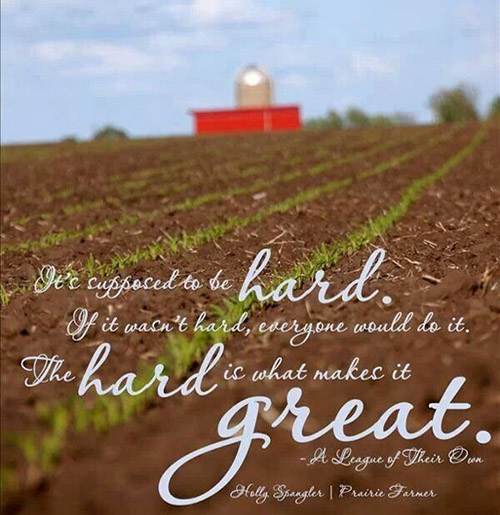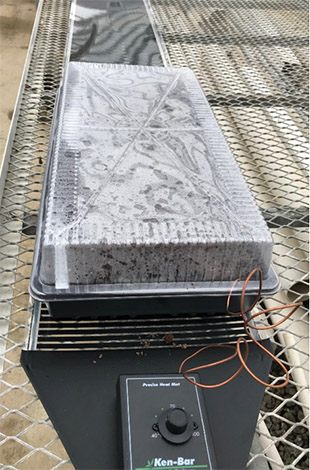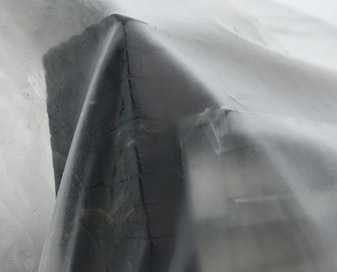Address any questions or comments regarding this newsletter to the individual authors listed after each article or to its editors, Nathan Johanning, 618-939-3434, njohann@illinois.edu or Bronwyn Aly 618-695-6060, baly@illinois.edu. The Illinois Fruit and Vegetable News is available on the web at: http://ipm.illinois.edu/ifvn/. To receive or be removed from email notification of new postings of this newsletter, contact Nathan Johanning or Bronwyn Aly at the phone numbers or email addresses above.
In This Issue:
Upcoming Programs (listings for beginning and established growers)
Regional Reports (southern Illinois, Dixon Springs)
Fruit and Vegetable Production and Pest Management (Modified Growing Degree Days for Insect Development, Cooler Winter Weather Sets the Stage for Corn Flea Beetles and Stewart's Wilt, Early Spring Reminders on Insect Management)
Upcoming Programs
Check the Illinois SARE calendar for a full list of programs and links for registration.
http://illinoissare.org/ and http://illinoissare.org/calendar.php
Also see the University of Illinois Extension Local Food Systems and Small Farms Team's website at:
http://web.extension.illinois.edu/smallfarm/ and the calendar of events at http://web.extension.illinois.edu/units/calendar.cfm?UnitID=629.
- Small Farms Winter Webinar Series, Thursdays, Starting January 25 through April 5, 2018, Noon to 1 p.m. Visit http://go.aces.illinois.edu/WinterWebinars to register or see the topics for this program. Also see the "News & Announcements" below for more details in the newsletter. For more information contact Zack Grant at 708-679-6889 or zgrant2@illinois.edu. To view previous, archived webinars visit : http://bit.ly/ILLocalFoodsYouTube
2018 Small Farms Winter Webinar Schedule- Mar. 8 - Native Pollinators on your Farm, Doug Gucker, University of Illinois Extension Local Food Systems and Small Farms Educator
- Mar. 15 – Small Acres Pastured Poultry, James Theuri, University of Illinois Extension Local Food Systems and Small Farms Educator
- Mar. 22 - Growing Ginger, Turmeric, and Other Unique Crops, Chris Enroth, University of Illinois Extension Horticulture Educator
- Mar. 29 - Tips for Modifying and Building Sprayers for Specialty Crops, Nathan Johanning, University of Illinois Extension Local Food Systems and Small Farms Educator
- April 5 - Less Common Fruit Bearing Plants, Elizabeth Wahle, University of Illinois Extension Commercial Ag Educator (Fruits and Vegetables)
- Fruit Tree, Chestnut, and Currant Propagation, Saturday, March 31, 2018 9 a.m. Refuge Food Forest 701 East Lincoln; Normal, IL 61761. Hands on workshop on grafting apples, and Asian and European pears, propagating red and black currants by root cuttings, planting and care for Chinese Chestnut seed. For more information and to register for this program visit https://web.extension.illinois.edu/registration/?RegistrationID=17486
- Asparagus Production Twilight Meeting, Monday, April 16, 2018, 6 p.m. Jackson County Extension Office, 402 Ava Rd.; Murphysboro, IL 62966. In field program, covering all aspects of asparagus production, including the asparagus variety trial at the office. Save the date and watch the next issue for details on registration. For more information contact Nathan Johanning at njohann@illinois.edu or 618-687-1727.
- 2018 Illinois Summer Horticulture Field Day, Thursday, June 7, 2018. Annual Illinois State Horticulture Society annual summer field day will by hosted by Flamm's Orchard in Alto Pass, IL. Save the date; more details closer to event.
- 2018 Pumpkin Field Day, Thursday, September 6, 2018, 10 a.m. Ewing Demonstration Center (located about 20 minutes south of Mt. Vernon, IL) 16132 N. Ewing Rd. Ewing, IL 62836. Pumpkin Variety & Pest Management trials, No-till Production and more! Save the date; more details to come! For additional information contact Nathan Johanning at 618-687-1727 or njohann@illinois.edu.
Regional Reports
From southern Illinois... We have stayed fairly wet in the last few weeks. Mainly from the storm system that was over us around the time the last issue came out. In total for the week of 2/19 (through Saturday), we ended up with about 5.5" of rain in Carbondale and 7.4" of rain at Dixon Springs. I did hear one report of totals as much as 11" in some locations. Needless to say that has at least mostly replenished our dry soils and things are wet. We have had about 2 to 2.5" of rain across the area since then with about 0.5 to 1" of that coming this past Monday. We have mainly been in the 50s and 60s for highs, but a front has come through in late Tuesday dropping highs to around 40° and lows in the mid to upper 20s. The forecast is for highs to stay in the 40s and 50s and some more rain chances by the weekend.
Given the weather, there isn't a whole bunch of activity out in the field quite yet. Pruning on tree fruit, grapes, brambles and blueberries is ongoing and now is the time to be thinking about applying dormant sprays for disease suppression and scale control. Over the weekend, I was at home at the farm in Monroe County and did my apple and peach pruning. So far everything looks good and no bud activity yet. We do have an old (probably Kiefer or similar) pear tree and when pruning it, I did notice a little bit of swelling and green starting to show on flower buds.
Now is the time to be considering your burndown and preemergence herbicide applications in asparagus. Down here we have seen asparagus emergence as early as mid-March in previous years and many of the herbicides need to be down a week or two before any fear of having emerged spear tissue. If you are using any form of glyphosate (ie Roundup), you want to make sure that no spears are emerged as it will kill emerged spears and can translocated to injury to the crown. Our best timings for herbicide applications in asparagus is now before emergence and then at the end of harvest. There are many burndown and residual herbicide options for asparagus and refer to the 2018 Midwest Vegetable Production Guide for more details.
Nathan Johanning (618-939-3434; njohann@illinois.edu)
From Dixon Springs Agricultural Center... Even with the heavy rains of last week and area flooding making things seem dreary, spring is in the air at DSAC. Seed orders and supplies have all arrived, generating excitement for the 2018 growing season!
The first round of seeding began this week with various varieties of tomato, pepper, cucumber, and flowers. It is important to reach and maintain optimum soil temperatures when starting seeds as this helps seeds to germinate in a timely manner and hopefully avoid damping off issues. By using 20 slot seeding trays, we are able to keep our varieties separated easily, labeling each individual row. We plan to have transplants ready for planting into the high tunnels by mid-April.
When putting the new plastic on the high tunnel last week, we were reminded of a small detail that could save someone a lot of unnecessary heartache. Remember to tape or cover any sharp edges that plastic might snag on and rip, potentially costing a few hundred dollars to buy a new roll of plastic, as well as losing valuable growing days waiting for replacement plastic to arrive. Granted small holes can easily be patched or repaired but it is always nice to start out hole free, if possible, with brand new plastic.
|
|
|
|
Bronwyn Aly (618-382-2662; baly@illinois.edu)
Fruit and Vegetable Production and Pest Management
Modified Growing Degree Days for Insect Development (Base 50°F, January 1 through March 4)
Station Location |
Actual Total |
Historical Average (11 year) |
One- Week Projection |
Two-Week Projection |
|---|---|---|---|---|
Freeport |
5 |
4 |
9 |
15 |
St. Charles |
19 |
7 |
24 |
30 |
DeKalb |
14 |
6 |
18 |
25 |
Monmouth |
19 |
14 |
25 |
35 |
Peoria |
30 |
18 |
37 |
49 |
Champaign |
30 |
20 |
37 |
50 |
Springfield |
51 |
24 |
59 |
74 |
Perry |
64 |
31 |
74 |
88 |
Brownstown |
60 |
43 |
72 |
89 |
Belleville |
92 |
55 |
104 |
123 |
Rend Lake |
94 |
58 |
108 |
128 |
Carbondale |
102 |
63 |
116 |
136 |
Dixon Springs |
129 |
75 |
145 |
167 |
Insect development is temperature dependent. We can use degree days to help predict insect emergence and activity. Degree day accumulations calculated using the Illinois IPM Degree-Day Calculator (a project by the Department of Crop Sciences at the University of Illinois and the Illinois Water Survey).
Kelly Estes, State Survey Coordinator, Illinois Cooperative Agricultural Pest Survey (217-333-1005; kcook8@illinois.edu)
Cooler Winter Weather Sets the Stage for Corn Flea Beetles and Stewart's Wilt
While the temperatures in January did little to affect average soil temperatures (https://blogs.illinois.edu/view/7447/618008), the same cannot be said for average air temperature. Average winter temperatures in Illinois for 2017-2018 were much colder than 2016-2017 (Figures 1 and 2). Cool temperatures during the months of December, January and February favor increased mortality of the corn flea beetle and the bacterium it vectors.

Figures 1 and 2. Average winter temperatures of 2016-2017 and 2017-2018.
Corn flea beetles are the primary vector of Stewart's wilt. Erwinia stewartii, the bacterium that caused Stewart's wilt, survives the winter in the gut of the corn flea beetle and the survival of the corn flea beetle is dependent on winter temperatures. Warmer winters result in greater survivorship of corn flea beetles, thus increasing the potential for Stewart's wilt. Using the average temperatures of December, January, and February, the potential for Stewart's wilt can be predicted (Table 1).
Table 1. Projected risk of Stewart's wilt based on the average temperatures of December, January, and February. | ||
|---|---|---|
Average temperature of December, January, & February |
Probability of early season wilt |
Probability of late season blight |
<27°F |
Absent |
Trace, at most |
27-30°F |
Light |
Light to Moderate |
30-33°F |
Moderate |
Moderate to Severe |
>33°F |
Severe |
Severe |
Corn flea beetles become active in the spring when temperatures rise above 65°F, and they feed on and transmit Stewart's wilt bacteria to seedling corn plants. The bacterium can spread systemically throughout the plant. Although most commercial field corn hybrids are resistant to Stewart's wilt, the disease is still a concern for susceptible seed corn inbreds and many sweet corn hybrids.
There are two phases of Stewart's wilt: the seedling wilt phase and the leaf blight phase. The seedling wilt stage occurs when seedlings become infected at or before the V5 stage. The vascular system becomes plugged with bacteria, causing the seedling to wilt, become stunted, and die. Infections of older corn plants usually result in the development of the leaf blight phase of Stewart's wilt. This phase is characterized by long, yellow to chlorotic streaks with wavy margins along the leaves. When the late infection phase or "leaf blight phase" of Stewart's wilt occurs after tasseling, it is generally not a concern in sweet corn because ears are harvested before damage occurs.
Based on the recent winter temperatures from the Midwest Regional Climate Center, early season Stewart's wilt is estimated to be absent to light in the northern half of the state, while the risk of in the southern portion is much greater. Remember, however, that these are only predictions; numbers of surviving corn flea beetles are not known.
Kelly Estes, State Survey Coordinator, Illinois Cooperative Agricultural Pest Survey (217-333-1005; kcook8@illinois.edu)
Early Spring Reminders on Insect Management
At the Illinois Specialty Crops, Agritourism, and Organic Conference at Springfield in January, the Illinois Specialty Growers Association requested that I resume contributing articles for the Illinois Fruit and Vegetable News. They offered me a small contract for this work, so ... here I am, back again, providing updates on insect management topics for the 2018 season. Efforts are ongoing to refill my previous position in some form at the University of Illinois, and I don't intend that my newsletter contributions take the place of a full-time entomologist serving the research and extension needs of fruit and vegetable industry in Illinois. I do hope to meet a small portion of those needs by providing some reminders and updates as the growing season progresses. A few topics for this time of the season and a few reminders for the upcoming months include:
- Prebloom emulsifiable oil applications for apples (and occasionally peaches). As apples reach green tip and develop to the stage where the pink color of fruit blossoms becomes visible, a long-standing and well-founded recommendation is to apply an emulsifiable oil (superior oil, dormant oil, etc.) in water at a rate of 2 gallons oil per 100 gallons water shortly after green tip. The goal is to cover thoroughly all the twigs and branches of trees so that when the water evaporates, a thin coat of oil remains. This oil coating covers the eggs of rosy apple aphid and European red mite, as well as the hard "scale" that covers San Jose scales that are present on branches and twigs. The oil coating blocks air exchange and suffocates these eggs and scales. In general, for most apple growers in Illinois, this application of oil should be made every spring ... it is relatively inexpensive and it does not harm the natural enemies of these or other pests. A couple of cautions ... (1) There is a little risk of greater cold injury to blossoms for a few days after application, so the standard guideline is to not apply an oil spray if temperatures are expected to drop below 27-28 degrees F for about 3 days after application. (2) As blossom buds swell and are about at pink, there is an increase in risk that oils might cause blossom damage; if you are unable to apply an emulsifiable oil until almost pink, reduce the concentration to ½ to 1 gallon oil per 100 gallons water. Emulsifiable oils can be used in the same way prebloom in peaches to reduce populations of San Jose scale and European red mite if these pests were a problem last year.
- Lorsban for added control of San Jose scale and rosy apple aphid and for control of woolly apple aphid. Lorsban Advanced 4E and Lorsban 75WG can be added to prebloom oil sprays on apples to improve control of rosy apple aphid and San Jose scale if infestations were a problem in the previous season. See pages 15-17 of the 2018 Midwest Fruit Pest Management Guide for rates and additional details on Lorsban, Esteem, and other insecticides that can be used prebloom in apples against these pests. Lorsban applied at this time also provides significant control of woolly apple aphids that move up and down trunks and branches for several weeks after application.
- Cutworms and flea beetles in early sweet corn and other vegetables. Not much new here, just a reminder ... by early April if not before, growers in some parts of the state will be planting sweet corn and planting or transplanting early-season vegetables, and high-tunnel crops will already be growing vigorously. My simple but often unheeded reminder is to scout those crops (walk through every planting and look closely for insects and damage) at least weekly if not twice per week. The earliest pests to cause problems in several vegetable crops are flea beetles (different species for different crop families) and cutworms (caterpillars that feed on foliage or cut stems). Some cutworm species overwinter as larvae in the soil and start feeding on plants as soon as temperatures allow plant growth. Black cutworm moths fly into the region from the south, often beginning on weather fronts in March. They prefer to lay eggs in weedy fields and cover crops, and larvae start feeding on those plants. When crops are planted and weeds are tilled or burned down with herbicides, the larvae feed on crop seedlings or transplants. Flea beetles overwinter as adults, often in areas with some ground cover or woody vegetation and move to vegetable crops as they emerge or are transplanted. If you are not familiar with these insects, for the crops you grow, google [flea beetle] or [cutworm] AND the name of the crop, and look for images so that you know what to scout for. Consult the 2018 Midwest Vegetable Production Guide for Commercial Growers for insecticide recommendations by pest and crop.
- Neonicotinoids. This class of insecticides remains in the news – rightfully so – because of concerns about their toxicity to bees. The most commonly used neonics in vegetable and fruit production are thiamethoxam (Actara, Platinum, FarMore seed treatments, and others), imidacloprid (Admire Pro and many generic products), clothianidin (Belay and common seed treatments for agronomic crops), and acetamiprid (Assail). Thiamethoxam, imidacloprid, and clothianidin are several hundred to a few thousand times more toxic to bees than commonly used pyrethroids, and because they are systemic, they can move in toxic amounts into pollen and nectar of treated crops. Assail (acetamiprid) is FAR less toxic to bees than thiamethoxam, imidacloprid, and clothianidin (and mush less systemic in plants) and can be considered roughly equal to most pyrethroids in toxicity to bees. My best summary on using these neonics is: (1) Thiamethoxam (Actara, Platinum, and Farmore seed treatments) and imidacloprid (Admire and others) should NOT be used during bloom in any crops nor should they be used within 3 (or more) weeks before bloom. In vegetables, thiamethoxam seed treatments applied to cucurbits appear to safe enough, as do drenches applied at or immediately after transplanting. They should not be used later in the period before bloom or at all during bloom. They should not be used in fields where flowering weeds attract pollinators. (2) Belay (clothianidin) should not be used before bloom in vegetables or fruits; it can be used safely in tree fruits after bloom IF orchards are relatively free of blooming weeds. (3) Assail can be used safely after bloom in tree fruit crops. It is not the best choice for aphid control in pumpkins because bloom continues throughout early fall when aphid control is most often necessary. Beleaf and Fulfill are effective against aphids in pumpkins and other crops and are very low in toxicity to bees. Among the less widely used neonicotinoids, dinotefuron (sold as Scorpion and Venom) is systemic and very highly toxic to bees and should be used (and NOT used) under the same guidelines as thiamethoxam and imidacloprid. Sivanto (flupyradifurone) and Closer and Transform (both contain sulfoxaflor) are in different subgroups (4C and 4D) of the neonicotinoids and are less toxic to bees; see precautions regarding pollinator protection on the labels of these insecticides.
Contributions from Weinzierl Fruit and Consulting, LLC are provided through support by the Illinois Specialty Growers Association. Visit www.specialtygrowers.org for more information or to join the association.
Rick Weinzierl, Weinzierl Fruit and Consulting, LLC (217-621-4957; raweinzierl@gmail.com)
Less Seriously...
Or maybe "more seriously" this issue....

http://www.quotationof.com/images/farming-quotes-1.jpg

http://i.pinimg.com/736x/25/37/f9/2537f9bef027aa6c3544d6c1fd468885.jpg
University of Illinois Extension Specialists in Fruit and Vegetable Production & Pest Management
Extension Educators – Local Food Systems and Small Farms |
||
Bronwyn Aly, Gallatin, Hamilton, Hardin, Pope, Saline, and White counties |
618-382-2662 |
|
Katie Bell, Franklin, Jackson, Perry, Randolph, & Williamson counties |
618-687-1727 |
|
Sarah Farley, Lake & McHenry counties |
847-223-8627 |
|
Nick Frillman, Woodford, Livingston, & McLean counties |
309-663-8306 |
|
Laurie George, Bond, Clinton, Jefferson, Marion, & Washington counties |
618-548-1446 |
|
Zachary Grant, Cook County | 708-679-6889 | |
Doug Gucker, DeWitt, Macon, and Piatt counties |
217-877-6042 |
|
Erin Harper, Champaign, Ford, Iroquois, and Vermillion counties |
217-333-7672 |
|
Grace Margherio, Jackie Joyner-Kersee Center, St. Clair County |
217-244-3547 |
|
Grant McCarty, Jo Daviess, Stephenson, and Winnebago counties |
815-235-4125 |
|
Katie Parker, Adams, Brown, Hancock, Pike and Schuyler counties |
217-223-8380 |
|
Kathryn Pereira, Cook County |
773-233-2900 |
|
James Theuri, Grundy, Kankakee, and Will counties |
815-933-8337 |
|
Extension Educators – Horticulture |
||
Chris Enroth, Henderson, Knox, McDonough, and Warren counties |
309-837-3939 |
|
Richard Hentschel, DuPage, Kane, and Kendall counties |
630-584-6166 |
|
Andrew Holsinger, Christian, Jersey, Macoupin, & Montgomery counties |
217-532-3941 |
|
Extension Educators - Commercial Agriculture |
||
Elizabeth Wahle, Fruit & Vegetable Production |
618-344-4230 |
|
Nathan Johanning, Madison, Monroe & St. Clair counties |
618-939-3434 |
|
Campus-based Extension Specialists |
||
Kacie Athey, Entomology |
217-244-9916 |
|
Mohammad Babadoost, Plant Pathology |
217-333-1523 |
|


